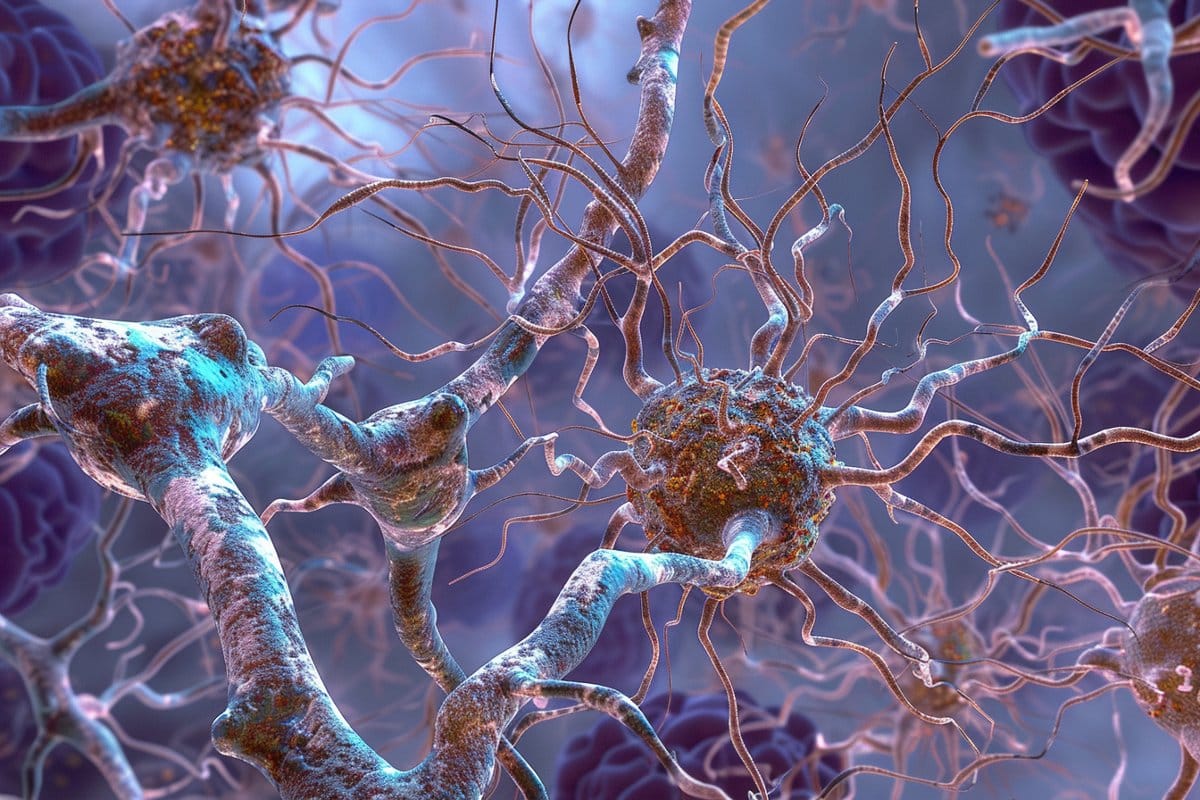Summary: Neurons in Alzheimer’s disease patients tend to re-enter the cell cycle and quickly progress to senescence. Using advanced snRNA-seq techniques, researchers analyzed over 30,000 nuclei to track these changes, finding that these neurons often fail to complete the cell cycle and instead show signs of aging.
This phenomenon, more pronounced in Alzheimer’s, Parkinson’s, and Lewy body dementia, could deepen our understanding of neurodegenerative diseases. The study introduces a robust bioinformatics tool that provides fresh insights into neuron behavior in diseased versus healthy brains.
Key Facts:
- Neurons that re-enter the cell cycle in neurodegenerative diseases like Alzheimer’s often fail to produce new cells and instead advance towards senescence.
- The study utilized snRNA-seq data to analyze the expression of approximately 350 cell cycle-related genes in individual neurons, revealing increased cell cycle re-entry in disease-affected brains.
- This research not only underscores the potential link between cell cycle re-entry and neurodegeneration but also introduces a new bioinformatics approach for studying these processes across different conditions.
Source: PLOS
Post-mitotic neurons in the brain that re-enter the cell cycle quickly succumb to senescence, and this re-entry is more common in Alzheimer’s disease, according to a new study published April 9th in the open-access journal PLOS Biology by Kim Hai-Man Chow and colleagues at the Chinese University of Hong Kong.
The phenomenon may provide an opportunity to learn more about the neurodegeneration process, and the technique used to make this discovery is readily applicable to other inquiries about unique populations of cells in the brain.
Most neurons in the brain are post-mitotic, meaning they have ceased to divide. For many years, it had been assumed that this post-mitotic state was permanent. Recent discoveries have shown that a small proportion of neurons re-enter the cell cycle, but little is known about their fate after they do.
To address this question, the authors turned to publicly accessible databases of “snRNA-seq” data, in which individual single nuclei are isolated and their RNA is sequenced, providing a snapshot of what a cell was doing at the time of isolation.
The cell cycle proceeds through distinct phases, including growth, DNA synthesis, division-specific growth, and mitosis, and each phase is characterized by a specific set of proteins required to carry it out. This allowed the authors to use the set of RNAs to tell them which phase of the cycle any specific nucleus was in.
Their data included information on over 30,000 nuclei, each of which was assigned a score based on the level of expression of a set of about 350 cell cycle-related genes.
They found that small populations of excitatory neurons had indeed re-entered the cell cycle. These cells did not, for the most part, continue successfully through the cell cycle to produce daughter neurons, however.
Instead, cells undergoing re-entry also had elevated expression of genes associated with senescence; in effect, the cells had reawakened only to enter senescence.
Intriguingly, the authors found that neurons in the brains of Alzheimer’s disease patients reentered the cell cycle at a higher rate, and that those neurons that had reentered the cell cycle and aged had increased expression of multiple genes associated with a higher risk of Alzheimer’s disease, including those that contribute directly to production of amyloid, the sticky protein that aggregates in the AD brain.
Similarly, brains from patients with Parkinson’s disease and Lewy body dementia had an increase in the proportion of re-entering neurons compared to healthy brains.
The neurobiological significance of this heightened re-entry for the diseased brain is still unclear, but the analytical approach taken here may offer deeper insights into neuronal subpopulations within the brain, as well as shedding light on disease mechanisms in neurodegenerative diseases.
“Because of the rare existence and random localization of these cells in the brain, their molecular profiles and disease-specific heterogeneities remain unclear,” Chow said.
“While experimental validations of these findings in relevant human samples will be conducted in the future, the applicability of this analytical approach in different diseases and cross-species settings offers new opportunities and insights to supplement mainstay histological-based approaches in studying the roles of these cells in brain aging and disease pathogenesis.”
The authors add, “This bioinformatics analytical pipeline demonstrated will offer the field a new tool to unbiasedly dissect cell cycle re-engaging and senescent neurons, and to dissect their heterogeneities in healthy versus disease-affected brains.”
About this Alzheimer’s disease research news
Author: Claire Turner
Source: PLOS
Contact: Claire Turner – PLOS
Image: The image is credited to Neuroscience News
Original Research: Open access.
“Neuronal cell cycle reentry events in the aging brain are more prevalent in neurodegeneration and lead to cellular senescence” by Kim Hai-Man Chow et al. PLOS Biology
Abstract
Neuronal cell cycle reentry events in the aging brain are more prevalent in neurodegeneration and lead to cellular senescence
Increasing evidence indicates that terminally differentiated neurons in the brain may recommit to a cell cycle-like process during neuronal aging and under disease conditions.
Because of the rare existence and random localization of these cells in the brain, their molecular profiles and disease-specific heterogeneities remain unclear.
Through a bioinformatics approach that allows integrated analyses of multiple single-nucleus transcriptome datasets from human brain samples, these rare cell populations were identified and selected for further characterization.
Our analyses indicated that these cell cycle-related events occur predominantly in excitatory neurons and that cellular senescence is likely their immediate terminal fate.
Quantitatively, the number of cell cycle re-engaging and senescent neurons decreased during the normal brain aging process, but in the context of late-onset Alzheimer’s disease (AD), these cells accumulate instead.
Transcriptomic profiling of these cells suggested that disease-specific differences were predominantly tied to the early stage of the senescence process, revealing that these cells presented more proinflammatory, metabolically deregulated, and pathology-associated signatures in disease-affected brains.
Similarly, these general features of cell cycle re-engaging neurons were also observed in a subpopulation of dopaminergic neurons identified in the Parkinson’s disease (PD)-Lewy body dementia (LBD) model.
An extended analysis conducted in a mouse model of brain aging further validated the ability of this bioinformatics approach to determine the robust relationship between the cell cycle and senescence processes in neurons in this cross-species setting.

Rachel Carter is a health and wellness expert dedicated to helping readers lead healthier lives. With a background in nutrition, she offers evidence-based advice on fitness, nutrition, and mental well-being.







